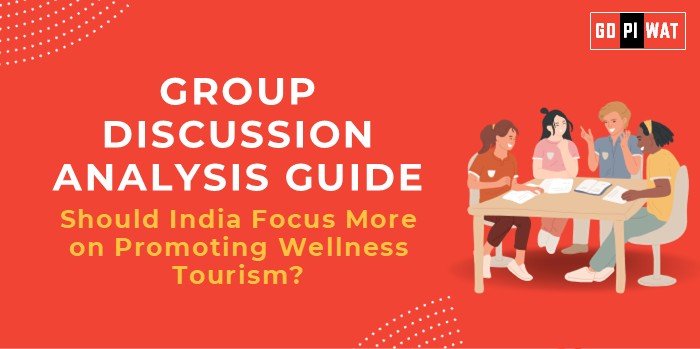📋 Group Discussion Analysis Guide: Should India Focus More on Promoting Wellness Tourism?
🌿 Introduction to Wellness Tourism
- 💡 Opening Context: Wellness tourism, focusing on health and well-being during travel, has gained significant momentum globally. With its rich heritage in Ayurveda, yoga, and naturopathy, India is uniquely positioned to dominate this burgeoning sector.
- 📜 Topic Background: Wellness tourism contributes to sustainable economic growth, improves employment opportunities, and promotes India’s soft power globally. India’s Ministry of Tourism has identified wellness tourism as a priority sector under the “Incredible India” campaign.
📊 Quick Facts and Key Statistics
- 🌍 Global Wellness Economy: Valued at $4.5 trillion (2023), wellness tourism is the fastest-growing segment.
- 📖 India’s Heritage Advantage: Over 5000+ years of traditional medicine systems like Ayurveda and yoga.
- 🧳 Tourist Demographics: 10 million international tourists in 2022; wellness tourists spend 50% more than the average tourist.
- 💰 Government Initiatives: INR 200 crore allocated for wellness tourism development in the Union Budget 2024.
👥 Stakeholders and Their Roles
- 🏛️ Government Agencies: Tourism Ministry promotes wellness hubs; AYUSH Ministry ensures quality standards.
- 🏨 Private Sector: Resorts and wellness centers are innovating with luxury Ayurveda retreats.
- 🌱 Local Communities: Actively involved in eco-tourism and cultural preservation.
- 🌍 Global Organizations: WHO promotes traditional medicine, boosting India’s credibility.
🏆 Achievements and Challenges
✨ Achievements
- 🧘♂️ India hosts over 50 million yoga practitioners globally.
- 🌴 States like Kerala have established world-renowned Ayurvedic hubs.
- 🤝 International partnerships for promoting wellness tourism (e.g., Yoga Day).
⚠️ Challenges
- 🚧 Infrastructure gaps: Limited connectivity to rural wellness hubs.
- 🔎 Regulatory challenges: Unregulated wellness practices dilute trust.
- 🏝️ Competition: Countries like Thailand and Bali have established stronger global branding.
🌍 Global Comparisons
- 🇹🇭 Thailand: Spa tourism excels with integrated marketing and infrastructure.
- 🇮🇩 Bali: Known for luxury wellness retreats attracting global tourists.
📖 Case Study
Kerala’s tourism strategy has seen a 20% rise in wellness tourists annually, contributing INR 10,000 crore to the economy.
💬 Structured Arguments for Discussion
- 💪 Supporting Stance: “India’s wellness tourism is an untapped goldmine that can boost GDP while promoting cultural heritage globally.”
- ⚖️ Opposing Stance: “Without infrastructure and regulatory improvements, wellness tourism risks being unsustainable and underutilized.”
- 🤝 Balanced Perspective: “Wellness tourism is promising but requires systemic investment and international marketing.”
📚 Effective Discussion Approaches
- 📊 Opening Approaches:
- 📜 Statistical Impact: “Wellness tourism globally is worth $4.5 trillion, and India has a significant competitive edge in this space.”
- ⚖️ Contrast: “While India leads in yoga and Ayurveda, its share of the global wellness market remains below potential.”
- 🔄 Counter-Argument Handling:
- “True, infrastructure is a challenge, but Kerala’s model shows how focused investments yield results.”
🔎 Strategic Analysis of Strengths and Weaknesses
- 💪 Strengths: Rich heritage, government support, low costs compared to competitors.
- 🛑 Weaknesses: Poor connectivity, lack of global marketing.
- 🌟 Opportunities: Post-pandemic focus on wellness, collaborations with global wellness organizations.
- ⚠️ Threats: International competition, over-commercialization risks.
🎓 Connecting with B-School Applications
- 📊 Real-World Applications: Feasibility studies on wellness tourism in rural regions or urban wellness hubs.
- ❓ Sample Interview Questions:
- 📜 “How can wellness tourism contribute to India’s GDP?”
- 📜 “Compare India’s wellness tourism model with Thailand’s.”


